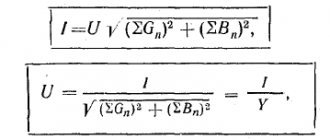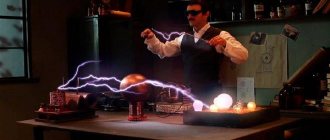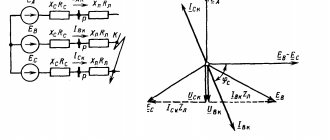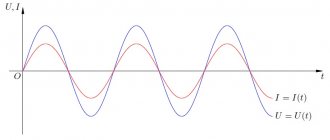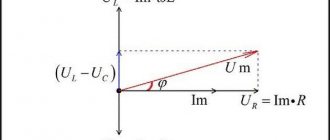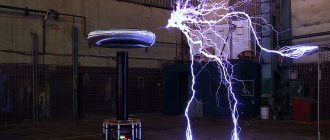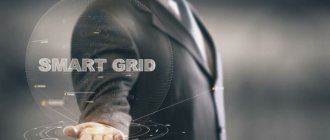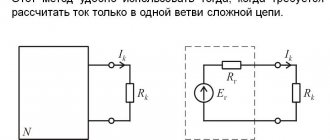Alternating current
DC - direct current, AC - alternating current
Before you can learn to use alternating current, you must first obtain it. In general, physicists have known about alternating current for a long time (since the discovery of electromagnetic induction) and Tesla did not discover it as such, but then everyone believed that alternating current was simply “garbage” that was unlikely to be used somehow. Tesla had a different opinion and immediately saw the full potential of alternating current.
Direct current flows continuously in one direction; AC current changes direction 50 or 60 times per second and can vary voltage to high levels while minimizing power loss over long distances. Later, the AC voltage can be lowered to be used in factories or homes. Tesla realized that the future belonged to alternating current.
Tesla described his motors and electrical systems in the paper "A New System of Alternating Current Motors and Transformers," which he presented at the American Institute of Electrical Engineers in 1888. It was then that George Westinghouse became interested in Tesla's developments, and one day he visited his laboratory and was amazed at what he saw. Nikola Tesla built a model of a polyphase system from step-down and step-up AC transformers, as well as an AC motor. Thus began the partnership between Wetsinghouse and Tesla. Nikola Tesla later received 40 patents for his inventions in the United States, and Westinghouse bought them all to provide himself with wealth and America with alternating current.
Below we will talk about these machines and how a multiphase power supply system was introduced in the USA.
Differences from other types
If you look at the graphs of the main types of electric current, then no questions will arise. The constant line will be straight, remaining at the same level over time, the variable line will be sawtooth. Unlike the latter, the first does not have such a parameter as frequency, or rather, in this case it is zero. In addition, the direction of direct current does not change over time. The designation also differs - DC (direct current) and AC (alternating current). As you might guess, the first is constant, and the second is variable. In addition, the latter type can be either single- or three-phase. This is where the main differences lie.
Alternator
An alternator is an electrical machine that is an integral part of Tesla's polyphase power supply system, which will be discussed below. A generator creates alternating current using mechanical work (for example, generators installed on dams using water falling on their blades).
We will not explain the principle of operation of the generator. Watch the video below if you want to understand more.
Tesla's alternator (another name for alternating current generator) was superior to all others for the simple reason that it was truly effective in practice. Tesla invented his generator while still in his 2nd year and even then he approached his teachers with the idea of using alternating current, but everyone dismissed his ideas as crazy. Some professors even simply laughed at his inventions.
In 1882, Tesla works in Paris and creates the first working prototype of his generator.
Arriving in the USA in 1884, Tesla went to the then famous inventor and businessman in the field of electricity, Thomas Edison, and got a job with him. Along the way, Tesla offered Edison his ideas for using alternating current, but Edison believed that he was crazy for thinking that alternating current could be used in any way. It even got to the point that Tesla, not understanding Edison’s sarcasm, thought that he would receive a large sum from Edison if he made several dozen specific inventions to order. Tesla made them, and Edison said that he was joking, and Tesla recommended that he learn to understand American humor.
In 1891, Tesla received a US patent for the world's first alternator.
Alternator 1891
Tesla Patent for Alternating Current Generator
Tesla polyphase generator with a power of 500 hp. (about 370 kW) at the Westinghouse exhibition
[edit] Topsy's plight
They led the elephant through the streets... Then they killed it.
Execution of Topsy. Greenpeace has been indignant for a hundred years In 1903, in New York's Luna Park, a trainer taught a baby elephant a new trick: the elephant eats an unextinguished cigarette and bows. Topsy, rightly judging with her big head that if a drop of nicotine kills a horse, then this poison is not good for the young, fragile elephant’s body, sent the trainer to the Land of the Eternal Hunt, and so that he would not be bored, she organized for him a company of two unlucky anonymous people, tucked under the trunk. So it goes.
And in the USA, even for less reckless mischiefs, blacks were hanged, what can we say about elephants. At first they were going to hang him the old fashioned way, but animal rights activists intervened, and Edison showed up right there with a “dangerous” alternating current, so they chose the humane method of execution by electricity. But remembering, to put it mildly, the not very successful first use of the electric chair on a person, they fed Topsy half a centner of carrots flavored with half a kilo of potassium cyanide. And they killed the elephant, peace be upon her ashes, into which she began to turn even during her fall. 6660 volts is not even a pellet for an elephant. Luna Park then, of course, burned to the ground, but that's a completely different story.
Pear-pear, but cunning Edison also made money at the public festivities: out of 15k applicants, only 2,000 managed to buy entrance tickets, plus some money was raised by duplicating a film with a recording of the execution, which has survived to this day and is already posted for free on YouTube.
AC motor
An alternating current motor or asynchronous machine is another stage in the development of ideas for the use of alternating current. We have already discussed the alternating current generator, which means we get electricity, but what to do with it next? We don’t have machines that run on alternating current! Tesla invented them.
Tesla's 1888 electric motor patent
In the 1880s, many inventors tried to invent working versions of alternating current motors, but they failed. Galileo Ferraris is engaged in theoretical research into the creation of alternating current motors and comes to the erroneous conclusion that they simply cannot be efficient and commercially successful. This added motivation to inventors around the world; it sounded like a challenge to create an efficient AC motor. Tesla answers this challenge and demonstrates his first version of an alternating current engine in 1887, and in 1887 he improves his model by releasing a second car.
One of Tesla's original electric motors from 1888.
The main reason why rational use of AC motors seemed impossible was that they were single-phase. Tesla justified theoretically and proved practically that it is possible not to limit oneself to one phase, but to make two or more phases.
The picture below shows schematically the structure of two- and three-phase AC motors:
Tesla later invents and patents many modified motors and AC motors. All these patents, as stated above, are sold by Tesla to Westinghouse.
Two-phase AC electric motor from the Westinghouse collection.
4-phase AC electric motor from the Westinghouse collection.
Polyphase AC electric motor from the Westinghouse collection.
Multiphase power supply system
Tesla noticed that Edison's DC power stations were inefficient, and Edison had already built up the entire Atlantic coast of the United States with them. To overcome the disadvantages of direct current, it was necessary, according to Tesla's idea, to use alternating current. Such a system is called multiphase because motors and generators have several phases (see explanations above).
Edison lamp
Edison's lamps were weak and inefficient when using direct current. This entire system had one major drawback in that it could not transport electricity over distances of more than 3 km due to its inability to vary the voltage to the high level required for long distance transmission. Therefore, DC power plants were installed at intervals of 3 km.
Scheme of operation of multiphase power supply systems
Alternating current, as written above, could reach high voltages and therefore could be transmitted over vast distances (go outside the house and look at the nearest high-voltage power lines, this is it).
When Edison learned that he had such a powerful competitor, he realized that he could lose his DC empire. This is exactly how the war began between Westinghouse and Tesla against Edison, which will be called the war of currents. Edison began strenuously trying to discredit Tesla's invention by showing that alternating current was more dangerous to life than direct current.
It is also worth noting that when Tesla came to the USA, he first offered his developments to Edison, but he called it all nonsense and madness.
Edison shocked animals with alternating current in public to infuriate them and prove that this type of current was dangerous. One day Edison learned about a doctor's idea about using alternating current to kill people. Realization was not long in coming. This is how the electric chair was invented, which was first used on William Kemmler, who was guilty of murdering his mistress.
For a long time, Edison could not come up with a name for his new invention, but he liked the word “Westinghouse” most of all, although none of them, as we now see, caught on.
Sources and Amplifiers
Of course, direct current does not come out of nowhere. There are special devices that generate it. These are ordinary batteries, accumulators and other modern sources. The first of them was the same Volta galvanic cell. But sometimes current needs to not only be generated, but also amplified. There are also special devices for this - direct current amplifiers (DCA). These devices are necessary in order to increase the voltage. An amplifier in the full sense can be called a UPT if its operating range includes all frequencies, down to the lowest, and zero. These devices are in great demand and are widely used in many areas of electronics, so their development and improvement is ongoing.
Tesla coil or transformer
Tesla invented his coil around 1891. At that time, he was repeating the experiments of Gernich Hertz, who had discovered electromagnetic radiation three years earlier. Tesla decided to run his device in conjunction with a high-speed alternator he was developing as part of an improvement to the arc lighting system, but he discovered that the high-frequency current overheated the steel core and melted the insulation between the primary and secondary windings in the Ruhmkorff coil, which was the default in the Hertz's experiments. To eliminate this problem, Tesla decides to change the design so that there is an air gap between the primary and secondary windings, instead of insulating material. Tesla made it so that the core could be moved to different positions in the coil. Tesla also installed a capacitor, which is usually used in such installations, between the generator and its primary winding coil, to prevent the coil from burning out. By experimenting with the settings of the coil and capacitor, Tesla discovered that he could take advantage of the resulting resonance between them to achieve higher frequencies.
In the Tesla transformer coil, the capacitor, after striking a short spark, was connected to a coil of several turns (primary coil), thus forming a resonant circuit with an oscillation frequency, usually 20-100 kHz, determined by the capacitance of the capacitor and the inductance of the coil.
The capacitor was charged to the voltage required to break the air spark gap during the input linear cycle, which reaches approximately 10 kilovolts using a linear transformer that is connected across the air gap. The linear transformer was designed to have a higher than normal leakage inductance (a parameter reflecting the non-ideality of the transformer) to withstand a short circuit occurring while the gap remained ionized, or for a few milliseconds until the high frequency current disappeared.
The spark gap was adjusted to break down at a voltage slightly less than the peak output voltage of the transformer to maximize the voltage across the capacitor. The sudden current passing through the spark gap causes the primary resonant circuit to resonate at its resonant frequency. The ring primary winding magnetically couples energy to the secondary winding over several RF cycles until all the energy that was originally in the primary winding is transferred to the secondary winding. Ideally, the gap then stops conducting current (quenching), trapping all the energy in the oscillating secondary circuit. Usually the gap begins to grow again, and the energy from the secondary transmissions returns to the primary circuit within a few more RF cycles. The energy cycle can be repeated several times until the spark gap finally weakens. As soon as the gap stops conducting current, the transformer will begin to charge the capacitor. Depending on the spark gap breakdown voltage, it may fire many times throughout the AC cycle.
A more prominent secondary winding with significantly more turns of finer wire than the secondary winding was positioned to intercept part of the primary winding's magnetic field. The secondary system was designed to have the same resonance frequency as the primary, using only the stray capacitance (unwanted capacitive coupling) of the winding itself to ground, as well as any terminal located at the top of the secondary winding. The lower end of the long secondary winding must be grounded.
Applications of Tesla Coils
Applications can be divided into practical and purely decorative. Practical applications of Tesla coil current are found in radio control, radio and wireless power transmission to power various devices (for example, light bulbs). Tesla's generator also discovered an unexpected application in medicine. Arsene D'Arsonval used the currents created by the generator for physiotherapeutic effects on the surface of the skin and mucous membranes of various human organs. The current passed through the surface layers of the skin and had a tonic and healing effect. Tesla coils are also used to operate gas-discharge lamps and detect leaks inside vacuum systems.
But Tesla coils have become much more widespread in the field of special effects and decorations, because the discharges created by a Tesla transformer look extremely impressive and beautiful.
You can see an example of how a Tesla coil works in the video:
It is also interesting to observe the musical properties of these coils, which are achieved by changing the frequency:
Interestingly, at one time in the 20th century they tried to sell Tesla coils as an effective way to protect your car from theft:
Also, similar reels are used in various centers to entertain visitors and try to captivate young people with the beauty of physical effects, as well as in attractions:
Let there be light
Many are convinced that in 1870 Thomas Edison personally invented electric lighting. It is not true. The first electric lamp was the arc lamp by Humphry Davy (1807). Davy constructed a huge electric battery in the basement of the Royal Institution of London, inspired by a similar invention by Alessandro Volta in 1800.
To demonstrate the power of his battery, Davy connected two carbon rods to its terminals. When he spread the rods a short distance and passed a current through them, a bright arc of light formed between them.
Over the next fifty years (1810–1860), inventors worked on arc lamps with electromechanical controls that helped set the exact distance between the rods to create the arc. However, all their research was limited by the power of the batteries. To further advance this field, a new power source was required.
Michael Faraday, 19th century English chemist, physicist and inventor
Such a source was a dynamo, also known as a generator. In 1831, Davy acquired a new laboratory assistant, Michael Faraday. He discovered that when a conductor was introduced into a magnetic field at the desired angle to this field, an induced current arose in the conductor. Based on Faraday's principle of electromagnetic induction, inventors designed new electric current generators. They had to be wound manually or powered by a steam engine.
The ability to use arc lamps to illuminate streets and large buildings inspired other electricians to retrofit the generator. In 1876, Charles Brush of Cleveland designed a direct current generator that powered four arc lamps in a series circuit. This design was used in street lighting, factories and stores, including Wanamaker's department store in Philadelphia.
Arc lamps were ideal for lighting streets and houses. Even today they are used in powerful spotlights, widely used at the opening of new stores or large-scale film premieres.
Engraving by William Allen Rogers for 1889 Harper's Weekly magazine. It depicts the electric lighting of New York at night.
Wireless lighting
In 1891, Tesla improved the wave transmitter invented by Hertz, which was needed for radio frequency energy supply, by converting it into a lighting system consisting of gas-discharge lamps.
That same year, he demonstrated his invention at Columbia College.
When we say that lighting is wireless, we do not mean radio waves, we are talking about electrostatic induction.
In Tesla's hands are two long Geissler tubes, which look like neon lamps.
In 1893, a world exhibition is held in Chicago, where Tesla demonstrates his invention. The lamps were not only wireless, but also fluorescent.
In 1894 a new achievement. He manages to light a phosphorus incandescent lamp in his laboratory using the resonant method of mutual induction.
True, such a lamp could not find wide commercial application, but the resonant inductive coupling method is now used everywhere in electronics.
Edison and incandescent lamps
If you needed a smaller source of soft electric light, arc lamps were no longer an option. Edison quickly realized that he could sell small light bulbs as a replacement for the gas lamps of that time. In 1878 he abandoned his work on the telephone and phonograph and plunged headlong into the world of electric lighting, about which he had known nothing until that moment.
An 1879 lamp with a carbon filament that glows when current is passed through it. PHOTO: SSPL, GETTY
To create a smaller lamp, Edison decided to turn to the incandescent effect (the so-called glow when heated). When the critical temperature is reached, the object emits bright light. At first, Edison experimented with platinum. This metal has a high melting point, so the inventor suggested that a current could be passed through a platinum thread and make it glow.
However, he immediately discovered that oxygen was also involved in the process. The platinum burned out almost immediately. Then Edison placed a metal thread in a vacuum glass flask. This solved the combustion problem, but platinum was too expensive and also had low electrical resistance.
This meant that such a lighting system would require expensive and very thick copper cables. Fortunately, Edison solved this problem by simply increasing the resistance in each lamp and connecting them in parallel circuits.
Now it was necessary to find a metal with a sufficiently high resistance. Edison and his team spent several months selecting and testing materials until they discovered that lamp black, used in telephone transmitters, was best suited for this purpose. This is how the opening moment was described in one of the newspapers:
“One night, while sitting in his laboratory working on an unfinished project, Edison began mindlessly rolling a piece of compressed lamp black between his fingers until he rolled it into a thin thread. One chance glance gave him the idea that he could try to heat it up. A few minutes later he conducted a completely successful experiment, although the results did not surprise him. Further tests helped to find a suitable form and composition of the substance, and the result of each experiment confirmed that the inventor was on the right track.”
Illustration from Currier & Ives, late 1800s. Edison (left) and arc lamp inventor Charles Brush battle to light New York City.
In October 1879, Edison and his team conducted the first successful experiments: they placed a carbon filament in a vacuum flask and heated it so that it did not burn. By the New Year's holiday, Edison was already in full swing demonstrating the new lamps to crowds of people in his laboratory in Menlo Park.
However, this was not enough to enter the consumer market. Now Edison had to design the entire electrical system to power his lamps. He modeled it on gas lighting systems used in large cities. They consisted of central stations, underground communications, meters and clamping fixtures for the lamps themselves. Edison built the first central station on Pearl Street in lower Manhattan in 1882. The famous Wall Street and the offices of the New York press were located here. The location was chosen ideally; now Edison had access to both financiers and media people.
Before installing the station, he sent his people to survey the area and count the gas and kerosene lamps that could be replaced with new lighting. To offset the high cost of copper electrical grids to power the lamps, Edison designed a direct current system for densely populated inner city neighborhoods. Serving customers within a radius of just under two kilometers from the central station turned out to be quite profitable.
LARGE INVENTION BUSINESS
Men pose outside the building of Edison's company, Edison Machine Works. PHOTO: CORBIS, GETTY
To produce and bring incandescent lamps to market, Edison needed the appropriate infrastructure. He designed a whole system to power his lamps, but didn't stop there. Being an enterprising businessman, he founded companies for the production of lamps, generators, cables and meters: Edison Lamp Works, later renamed Edison ElectricLamp Company, Edison Machine Works, and so on.
Despite the fact that a few years later he lost the “battle of the currents,” Edison’s companies remained afloat. In 1889, they merged to form the Edison General Electric concern, which later changed its name to simply General Electric.
Tesla Tower
Tesla did not stop at the wireless lighting system and went further. He decided that it was possible, in principle, not to use high-voltage wires to transmit current and transmit all electricity through air. To do this, he wanted to build a huge experimental facility in New York, known as the Tesla Tower or Wardenclyffe Tower. Later, while conducting his experiments and observations on lightning, Tesla came to the erroneous conclusion that he could use the entire globe to conduct current.
One of the pages of the Tesla Tower patent
He received money for construction from the then famous financier J.P. Morgan, to whom he informed that the tower would be used for transatlantic wireless telephony and broadcasting, from which Morgan planned to make money. In fact, it was the first such tower of its kind.
Construction of the tower began in 1901 and continued until 1903. A second receiving tower was planned to be built near Niagara Falls. When the first tower in Wardenclyffe was almost completed, Morgan realized that wireless transmission of electricity could lead to the collapse of the entire market in which he had investments (he owned the Niagara Hydroelectric Power Station), so he stopped financing Tesla's project. In May 1905, Tesla also lost his patent income upon expiration, so he went bankrupt and was never able to complete the second tower.
How does the Tesla Tower work?
The tower at Wardenclyffe was a huge Tesla coil, about 60 meters high, with a large copper sphere on top. The tower generated lightning up to 40 meters long, and the thunder from the released electricity generated thunder that could be heard 24 kilometers from the tower. The weight of the tower reached 55 tons, and the diameter was 21 meters.
Wardenclyffe Tower from the inside
In 1905, a test launch was carried out, which had a shocking effect. The newspapers wrote that Tesla managed to light up the sky over the ocean for thousands of miles. Around the tower itself, horses received electric shocks and even the wings of butterflies became electrified to such an extent that “St. Elmo’s Fire” (corona discharge) could be seen around them.
Unfortunately, the tower was demolished in 1917.
Invention of radio and radio control
Tesla shows off its radio-controlled boat
The 20th century is extremely rich in various inventions and technical innovations. Many were invented in parallel in various variations, while some patented their inventions, while others could not or did not want to do this for some reason. Therefore, it is quite difficult to establish who was the first to invent radio. For example, in the USA, radio is believed to have been invented by David Hughes, Thomas Edison and Nikola Tesla, who made relevant technical contributions to this invention; in Germany it is believed that radio was invented by Heinrich Hertz, and in France by Edouard Branly; In Belarus, Yakov Narkevich-Iodka is considered the inventor of radio; In Brazil it is believed that the inventor of radio was Landel de Mourou; in England - Oliver Joseph Loggia; in the USSR, it was generally accepted to consider Alexander Stepanovich Popov as the inventor of radio, and so on for many more countries. Gugliermo Marconi should not be considered the inventor of radio as a technology or a complete system, but as the creator of the first commercially successful implementation of a radio system.
All of their patents and inventions appeared between 1880-1895 and they were all involved in the study of radio waves. Simply put, they were all inventors of radio to one degree or another, contributing to the development of the theory of information transmission.
But what did Tesla do? And he did a lot too. He described the principles by which it was possible to transmit a radio signal over long distances, conducted a number of his own experiments on signal transmission, and also created the first radio-controlled boat, which he demonstrated at an electrical exhibition in 1898. True, he did not believe that communication was possible using radio waves.
Nikola Tesla's radio-controlled boat
One of the pages of the patent for Nikola Tesla's radio-controlled boat
In the video you can see the boat, which was assembled in 2015 in the likeness of the one Tesla had:
The boat was controlled using radio control. Tesla demonstrated this boat in 1898 at the Electrical Exhibition at Madison Square Garden. There she made a splash. Imagine the people of that time who did not understand how Tesla controlled the boat, ordering it to sail to this or that place. Apart from the word “magic,” it was difficult to find anything here for the average person of that time.
Although newspapermen of that time immediately began to call Tesla’s invention a “radio-controlled torpedo” (apparently due to the fact that at that time Thomas Edison was trying to invent a similar torpedo and sell it to the military), Tesla himself did not aim at war. In 1900, Centure magazine interviewed the inventor, where he said that the purpose of his invention was an attempt to create “artificial intelligence,” since modern machines simply borrow the human mind and respond only to his orders. Tesla believed that one day people would be able to create a machine with a mind of its own. Well, after more than 100 years, we can still say that we have not created such a machine.
Later during World War II, the Nazis would use radio controls to create remote-controlled tanks.
We also recommend an interesting article about modern Russian developments in the field of combat robotics.
[edit] ICHSH
Modern methods of electrification make it possible to transmit direct current using power lines over considerable distances. Moreover, any types of consumers can work on it (in the sense of not human consumers, but consumers according to electrodynamics, that is, electrical appliances). The maximum effective range suddenly increases with increasing voltage and decreasing cross-section (for which suitable materials and technologies are available). At substations it is reduced with the help of TPT (as if you thought, direct current can also be transformed!). Moreover, all this is not on paper, but in some places it has been in metal for a long time and works. Innovation is considered promising, modern, stylish, fashionable and youthful, but either no one gives a fuck, or if it’s not broken, don’t fix it (which is again a subtype of the previous one), therefore a global transition to a permanent one is not planned yet.
Bladeless Tesla turbine
Tesla turbine from the museum
Tesla patented this turbine in 1913. The invention of a turbine without blades was essentially forced, since there were no suitable technologies for the manufacture of a turbine with blades, and the aerodynamic theory had not yet been created, so Tesla decided to use the boundary layer effect, rather than the pressure of a substance on the blades, as is now widespread in traditional turbines.
Tesla turbine design
You can often find statements that the efficiency of his turbine can theoretically reach 95%, but in practice at Westinghouse factories such a turbine showed an efficiency of around 20%. Although later, various modifications of the turbine by other inventors brought the efficiency to 40% or more.
Fluid path in a Tesla turbine
The operating principles of the Tesla turbine are explained very well in English in this video:
As of 2016, the Tesla turbine has not seen widespread commercial use since its invention. So far, it has managed to find a narrow application in pumps. This is primarily due to the fact that the disks inside the turbine are greatly deformed during operation and this affects the overall efficiency of the turbine. Although technological searches are now ongoing to solve all the problems that arise. More recently, the issue of disc deformation has been partially resolved using new materials such as carbon fiber.


